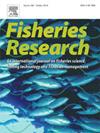Inferring population structure of mackerel icefish (Champsocephalus gunnari) between South Orkney Islands shelf and South Georgia shelf, Antarctic using otolith ecomorphological analyses
IF 2.3
2区 农林科学
Q2 FISHERIES
引用次数: 0
Abstract
As an important species in the Southern Ocean, the mackerel icefish (Champsocephalus gunnari) is not only a major food source for a wide range of top predators, but also a predominant consumer of a key species, Antarctic krill (Euphausia superba), in the Southern Ocean ecosystem. In the Scotia Sea, this species is commercially harvested at South Georgia. However, the studies on the population structure of this species are inconclusive. Combining Trait Probability Density and Ecological Niche Modeling analyses on otolith shape, this study investigated the diffidence in populations of C. gunnari between the South Orkney Islands shelf and South Georgia shelf. Significant differences were identified in the otolith shape characteristics and ecological niches of fish from these two regions, with otolith roundness and aspect ratio likely being the primary factors responsible for these differences. The results of these analyses indicate that populations are separated between the two regions. This multi-dimensional approach offers new insights for otolith study and valuable data for understanding the ecological niche and population structure of fish species, thereby enhancing our ability to effectively manage and conserve C. gunnari populations.
利用耳石生态形态学分析推测南奥克尼群岛和南乔治亚岛冰架间的鲭鱼种群结构
作为南大洋的重要物种,鲭鱼(Champsocephalus gunnari)不仅是各种顶级捕食者的主要食物来源,而且是南大洋生态系统中重要物种南极磷虾(Euphausia superba)的主要消费者。在斯科舍海,这个物种在南乔治亚岛被商业捕捞。然而,对其种群结构的研究尚无定论。结合耳石形态的特征概率密度和生态位模型分析,研究了南奥克尼群岛和南乔治亚岛陆架之间古纳利C. gunnari种群的差异。两区鱼类的耳石形状特征和生态位存在显著差异,耳石圆度和长径比可能是造成这些差异的主要因素。这些分析的结果表明,人口在两个地区之间是分开的。这种多维度的方法为耳石研究提供了新的见解,为了解鱼类生态位和种群结构提供了宝贵的数据,从而提高了我们有效管理和保护古纳里鱼种群的能力。
本文章由计算机程序翻译,如有差异,请以英文原文为准。
求助全文
约1分钟内获得全文
求助全文
来源期刊

Fisheries Research
农林科学-渔业
CiteScore
4.50
自引率
16.70%
发文量
294
审稿时长
15 weeks
期刊介绍:
This journal provides an international forum for the publication of papers in the areas of fisheries science, fishing technology, fisheries management and relevant socio-economics. The scope covers fisheries in salt, brackish and freshwater systems, and all aspects of associated ecology, environmental aspects of fisheries, and economics. Both theoretical and practical papers are acceptable, including laboratory and field experimental studies relevant to fisheries. Papers on the conservation of exploitable living resources are welcome. Review and Viewpoint articles are also published. As the specified areas inevitably impinge on and interrelate with each other, the approach of the journal is multidisciplinary, and authors are encouraged to emphasise the relevance of their own work to that of other disciplines. The journal is intended for fisheries scientists, biological oceanographers, gear technologists, economists, managers, administrators, policy makers and legislators.
 求助内容:
求助内容: 应助结果提醒方式:
应助结果提醒方式:


